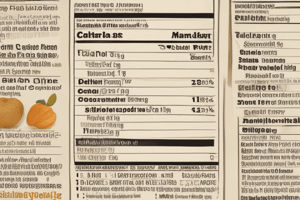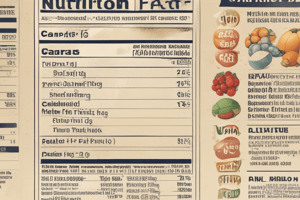Podcast
Questions and Answers
What are the two types of claims found on food labels?
What are the two types of claims found on food labels?
- Diet-Related and Plant-Based Claims
- Dietary and Nutritional Claims
- Front of Package and Ingredient List
- Nutrient Claims and Health Claims (correct)
Which of the following is NOT typically included in the Nutrition Facts table?
Which of the following is NOT typically included in the Nutrition Facts table?
- Serving Size
- Calories
- Ingredients List (correct)
- Total Fat
What is a key characteristic of a diet-related health claim?
What is a key characteristic of a diet-related health claim?
- It guarantees a certain health outcome for consumers.
- It focuses on the relationship between a food and a disease. (correct)
- It always refers to specific plant-based ingredients.
- It describes the level of a nutrient in a food.
Which of these is NOT commonly found in plant-based diets?
Which of these is NOT commonly found in plant-based diets?
What is the primary function of 'Front of Package Nutrition Labelling'?
What is the primary function of 'Front of Package Nutrition Labelling'?
What is one aspect of the eating pattern in diet planning?
What is one aspect of the eating pattern in diet planning?
Which statement best explains a principle of diet planning?
Which statement best explains a principle of diet planning?
What is a characteristic of highly processed foods?
What is a characteristic of highly processed foods?
Which of the following is NOT a component to be considered when designing a nutritious meal plan based on Canada's Food Guide?
Which of the following is NOT a component to be considered when designing a nutritious meal plan based on Canada's Food Guide?
How can food labels assist in achieving dietary goals?
How can food labels assist in achieving dietary goals?
What is an essential principle of a well-balanced plant-based meal plan?
What is an essential principle of a well-balanced plant-based meal plan?
What does the frequency of food consumption impact in a healthy diet?
What does the frequency of food consumption impact in a healthy diet?
Which nutrient-dense component is often overlooked in diet planning?
Which nutrient-dense component is often overlooked in diet planning?
Flashcards
Nutrition Facts Table
Nutrition Facts Table
A summary of the nutritional content of the food per serving.
Ingredient List
Ingredient List
A detailed list of all ingredients used in a food product, in order of quantity.
Front of Package Nutrition Labelling
Front of Package Nutrition Labelling
Simplified nutritional information displayed on the front of packaging.
Diet-Related Nutrient Claims
Diet-Related Nutrient Claims
Signup and view all the flashcards
Diet-Related Health Claims
Diet-Related Health Claims
Signup and view all the flashcards
Diet Planning Principles
Diet Planning Principles
Signup and view all the flashcards
Eating Pattern
Eating Pattern
Signup and view all the flashcards
Processed Food
Processed Food
Signup and view all the flashcards
Highly Processed Food
Highly Processed Food
Signup and view all the flashcards
Canada's Food Guide
Canada's Food Guide
Signup and view all the flashcards
Nutritious Meal Plan
Nutritious Meal Plan
Signup and view all the flashcards
Dietary Goals
Dietary Goals
Signup and view all the flashcards
Plant-Based Meal Plan
Plant-Based Meal Plan
Signup and view all the flashcards
Study Notes
Food Labels
- Food labels must include the product name, manufacturer contact, and best-before date (if applicable).
- Mandatory information: nutrition facts tables and ingredient lists.
- Allergens, gluten, and sulfites must be clearly labelled.
- Certain foods (coffee, spices, small businesses) are exempt from food labels, although processed foods require them.
- Bakeries do not require food labelling.
- Contact information for the manufacturer, packer, or distributor must be included.
Nutrition Facts Table
- Includes calorie count and macronutrients (e.g., fats, saturated and trans fats, cholesterol).
- Also lists essential nutrients like sodium, fiber, sugars, potassium, calcium, and iron.
- Provides percent daily values (although not for all items).
- The nutrition facts table contains 13 items.
- The serving size is clearly displayed.
- The % Daily Value is a guide for how much of a nutrient is in one serving of food compared to a daily diet. (5% or less is a little; 15% or more is a lot).
Ingredient List
- Must list all ingredients in descending order of weight.
- Ingredients must be listed by their common names.
- Sugars must be grouped together.
- Additives, preservatives, and fortificants are also included in the list.
- The ingredient list must include all ingredients, including additives, substances added in small quantities to preserve or enhance the food.
- Ingredients are listed in descending order of weight.
Front of Package Nutrition Labelling
- New requirements (January 2026) require manufacturers to clearly label foods high in saturated fat, sugar, and sodium.
- Designed to improve consumer awareness of potential health risks and encourage healthier choices.
- Newly added requirement that manufacturers must implement by January 2026 - this helps consumers quickly identify foods high in saturated fats, sugar, or sodium, which can aid in lowering the risk of chronic diseases.
Diet-Related Claims
- Nutrient Claims: describe the relationship between a nutrient and reducing the risk of a diet-related disease.
- Function Claims: describe the benefit of consuming a nutrient or other food component.
- Nutrient Function Claims: describe the role of a nutrient in maintaining health or growth.
- Diet-related claims are regulated by Canada's Food and Drug Regulation.
Plant-Based Diets
- Plant-based diets emphasize vegetables, fruits, whole grains, legumes, nuts, and seeds.
- They don't necessarily exclude meat and fish, but aim to reduce their consumption.
- This dietary approach aligns with current health recommendations, potentially reducing risks of obesity, diabetes, heart disease, etc.
- Vegetarian and vegan diets are specific types of plant-based diets.
- Vegan diets rely on fortified foods or supplements for essential nutrients (protein, iron, zinc, calcium, vitamin B12, vitamin D, omega-3 fatty acids).
- Plant-based diets align with current dietary recommendations, decreasing obesity, diabetes, hypertension, heart disease, and cancer risks.
Studying That Suits You
Use AI to generate personalized quizzes and flashcards to suit your learning preferences.




